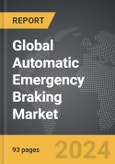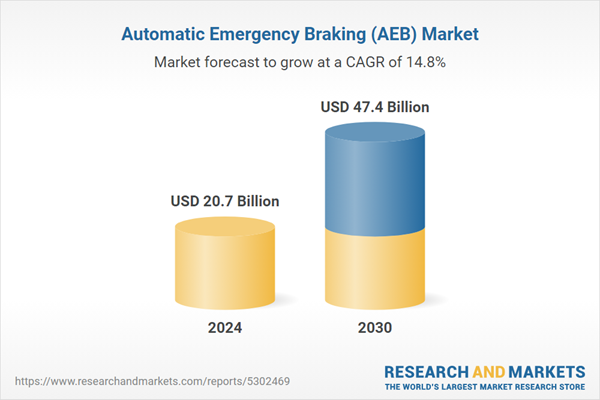Global Automatic Emergency Braking (AEB) Market - Key Trends and Drivers Summarized
What Is Automatic Emergency Braking and How Does It Work?
Automatic Emergency Braking (AEB) is a vehicle safety technology designed to prevent or mitigate collisions by automatically applying the brakes when a potential crash is detected. AEB systems use sensors, such as radar, cameras, and lidar, to continuously monitor the vehicle's surroundings and assess potential hazards, including other vehicles, pedestrians, cyclists, or stationary objects. When the system detects a high likelihood of collision, it initially alerts the driver with visual or auditory warnings. If the driver does not respond in time, AEB automatically engages the brakes to slow or stop the vehicle, either avoiding the collision entirely or reducing its severity. AEB technology is available in various configurations, including forward-collision AEB for frontal impact prevention, rear AEB to mitigate backing collisions, and pedestrian AEB to specifically identify and avoid hitting pedestrians. By actively intervening when a crash is imminent, AEB systems help reduce the risk of accidents, particularly those caused by driver inattention, distraction, or delayed reaction times.What Technological Innovations Enable the Effectiveness of AEB Systems?
The effectiveness of Automatic Emergency Braking relies on a combination of advanced sensor technologies, real-time data processing, and machine learning algorithms, each working together to create a responsive and intelligent braking system. The backbone of AEB is its sensor suite, which may include radar, cameras, and increasingly, lidar, allowing the system to detect and classify objects around the vehicle with high accuracy. Radar sensors provide reliable distance measurements and object detection in various weather conditions, while cameras capture detailed visual data to identify specific hazards, like pedestrians or cyclists. Lidar sensors, though less common in consumer vehicles, offer precise three-dimensional mapping, further enhancing the system's ability to detect objects accurately. Machine learning algorithms analyze the data from these sensors in real time, determining the probability of a collision and deciding when to initiate braking. Some AEB systems are also equipped with vehicle-to-vehicle (V2V) or vehicle-to-infrastructure (V2I) communication capabilities, which enhance their predictive capabilities by receiving data from other vehicles or infrastructure, helping to anticipate hazards beyond the line of sight. These technologies enable AEB systems to make rapid, accurate decisions that can mean the difference between a minor incident and a major accident.Where Is Automatic Emergency Braking Making the Greatest Impact?
Automatic Emergency Braking has proven to be a game-changer in both passenger and commercial vehicles, providing significant safety benefits across a range of driving scenarios. In passenger vehicles, AEB is particularly effective in urban environments, where frequent stop-and-go traffic, intersections, and pedestrian activity create conditions prone to low-speed collisions. AEB helps reduce rear-end collisions, one of the most common accident types, especially in congested traffic. For commercial fleets, AEB has become an invaluable tool in mitigating risks associated with larger, heavier vehicles, such as trucks and buses, which have longer stopping distances and higher collision impacts. Many delivery and logistics companies have adopted AEB to enhance driver safety and protect goods, especially in industries where drivers are on tight schedules, which can lead to fatigue and inattention. Even public transportation systems have integrated AEB into buses and trains to improve safety for both passengers and pedestrians. Beyond individual drivers and companies, AEB has a broader societal impact by reducing overall accident rates, alleviating the strain on emergency services, and lowering insurance costs. As more manufacturers equip their vehicles with AEB as standard or optional equipment, its impact on road safety continues to grow, making it an essential component of modern vehicle safety systems.What Factors Are Driving the Growth of the Automatic Emergency Braking Market?
The growth in the Automatic Emergency Braking market is driven by several factors, including advancements in sensor technology, regulatory pressures, and a rising consumer demand for enhanced vehicle safety features. One of the primary drivers is the technological progress in sensor systems, particularly in radar, camera, and lidar technologies, which have become more affordable, compact, and accurate, allowing more automakers to incorporate AEB into a wider range of vehicles. Regulatory requirements are also playing a major role; several countries and regions, including the European Union and the United States, have introduced or are considering mandates for AEB as standard equipment in new vehicles, especially for certain classes, like passenger cars and commercial trucks. Consumer demand for safety technology is another critical growth factor, as buyers increasingly prioritize advanced driver-assistance features like AEB, which contribute to peace of mind and reduce the risk of accidents. Additionally, the rise of electric and autonomous vehicles has accelerated the integration of AEB, as these vehicles often come equipped with more advanced sensor suites and rely on high-tech safety systems as part of their value proposition. The insurance industry is also influencing AEB adoption; insurers are offering lower premiums or incentives for vehicles equipped with AEB, as data shows that AEB-equipped vehicles are involved in fewer accidents, thus reducing overall risk. Together, these factors are propelling AEB market growth and positioning it as a cornerstone of the future of automotive safety, with widespread adoption expected in the coming years across both developed and emerging markets.Report Scope
The report analyzes the Automatic Emergency Braking (AEB) market, presented in terms of market value (US$ Thousand). The analysis covers the key segments and geographic regions outlined below.- Segments: Brake (Disc, Drum); Technology (Forward Collision Warning, Crash Imminent Braking, Dynamic Brake Support).
- Geographic Regions/Countries:World; United States; Canada; Japan; China; Europe (France; Germany; Italy; United Kingdom; Spain; Russia; and Rest of Europe); Asia-Pacific (Australia; India; South Korea; and Rest of Asia-Pacific); Latin America (Argentina; Brazil; Mexico; and Rest of Latin America); Middle East (Iran; Israel; Saudi Arabia; United Arab Emirates; and Rest of Middle East); and Africa.
Key Insights:
- Market Growth: Understand the significant growth trajectory of the Disc Brake segment, which is expected to reach US$28.9 Billion by 2030 with a CAGR of a 14%. The Drum Brake segment is also set to grow at 16% CAGR over the analysis period.
- Regional Analysis: Gain insights into the U.S. market, valued at $5.3 Billion in 2024, and China, forecasted to grow at an impressive 18.8% CAGR to reach $11.6 Billion by 2030. Discover growth trends in other key regions, including Japan, Canada, Germany, and the Asia-Pacific.
Why You Should Buy This Report:
- Detailed Market Analysis: Access a thorough analysis of the Global Automatic Emergency Braking (AEB) Market, covering all major geographic regions and market segments.
- Competitive Insights: Get an overview of the competitive landscape, including the market presence of major players across different geographies.
- Future Trends and Drivers: Understand the key trends and drivers shaping the future of the Global Automatic Emergency Braking (AEB) Market.
- Actionable Insights: Benefit from actionable insights that can help you identify new revenue opportunities and make strategic business decisions.
Key Questions Answered:
- How is the Global Automatic Emergency Braking (AEB) Market expected to evolve by 2030?
- What are the main drivers and restraints affecting the market?
- Which market segments will grow the most over the forecast period?
- How will market shares for different regions and segments change by 2030?
- Who are the leading players in the market, and what are their prospects?
Report Features:
- Comprehensive Market Data: Independent analysis of annual sales and market forecasts in US$ Million from 2024 to 2030.
- In-Depth Regional Analysis: Detailed insights into key markets, including the U.S., China, Japan, Canada, Europe, Asia-Pacific, Latin America, Middle East, and Africa.
- Company Profiles: Coverage of players such as Aisin Seiki Co., Ltd., Analog Devices, Inc., Autoliv, Inc., Continental AG, Delphi Automotive PLC and more.
- Complimentary Updates: Receive free report updates for one year to keep you informed of the latest market developments.
Some of the 42 companies featured in this Automatic Emergency Braking (AEB) market report include:
- Aisin Seiki Co., Ltd.
- Analog Devices, Inc.
- Autoliv, Inc.
- Continental AG
- Delphi Automotive PLC
- Denso Corporation
- Hyundai Mobis Co., Ltd.
- Knorr-Bremse AG
- Mando Corporation
- Paccar Inc.
This edition integrates the latest global trade and economic shifts into comprehensive market analysis. Key updates include:
- Tariff and Trade Impact: Insights into global tariff negotiations across 180+ countries, with analysis of supply chain turbulence, sourcing disruptions, and geographic realignment. Special focus on 2025 as a pivotal year for trade tensions, including updated perspectives on the Trump-era tariffs.
- Adjusted Forecasts and Analytics: Revised global and regional market forecasts through 2030, incorporating tariff effects, economic uncertainty, and structural changes in globalization. Includes historical analysis from 2015 to 2023.
- Strategic Market Dynamics: Evaluation of revised market prospects, regional outlooks, and key economic indicators such as population and urbanization trends.
- Innovation & Technology Trends: Latest developments in product and process innovation, emerging technologies, and key industry drivers shaping the competitive landscape.
- Competitive Intelligence: Updated global market share estimates for 2025, competitive positioning of major players (Strong/Active/Niche/Trivial), and refined focus on leading global brands and core players.
- Expert Insight & Commentary: Strategic analysis from economists, trade experts, and domain specialists to contextualize market shifts and identify emerging opportunities.
Table of Contents
Companies Mentioned (Partial List)
A selection of companies mentioned in this report includes, but is not limited to:
- Aisin Seiki Co., Ltd.
- Analog Devices, Inc.
- Autoliv, Inc.
- Continental AG
- Delphi Automotive PLC
- Denso Corporation
- Hyundai Mobis Co., Ltd.
- Knorr-Bremse AG
- Mando Corporation
- Paccar Inc.
Table Information
| Report Attribute | Details |
|---|---|
| No. of Pages | 276 |
| Published | December 2025 |
| Forecast Period | 2024 - 2030 |
| Estimated Market Value ( USD | $ 20.7 Billion |
| Forecasted Market Value ( USD | $ 47.4 Billion |
| Compound Annual Growth Rate | 14.8% |
| Regions Covered | Global |









